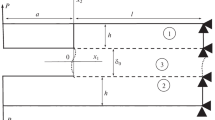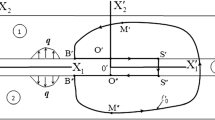Abstract
On the basis of the general variational formulation of the problem of the deformation of two bodies connected by a thin layer, a system of differential equations of equilibrium of the double-cantilever beam is obtained, taking into account the shear deformations of the cantilevers, both in the interface section and in the free section, taking into account also the elastoplastic properties of the layer. In this work, we use the connection representation of the J-integral in terms of the energy product and the energy product of dissipation. For purely elastic deformation, on the basis of the analytical solution of the system, an expression is obtained for the stress state of an extremely thin layer connecting the cantilevers, which is dependent on the material properties of both the layer and the cantilevers. The obtained expression for the elastic energy flux is compared with the known ones. The energy product at the top of the layer is found, the value of which depends only on the material properties of the consoles. With the elastoplastic behavior of the layer, the energy product of dissipation was found, which turned out to be dependent on the yield stress of the adhesive. The energy product in this case is proportional to the layer thickness. For adhesives with pronounced plastic properties, taking into account the dissipative mechanism of energy release leads to fundamental differences in the J-integral in comparison with the elastic calculation. The dependences of the DCB sample compliance with subcritical growth of the plastic deformation region in the adhesive are plotted.








Similar content being viewed by others
References
Andrews MG, Massabò R (2007) The effects of shear and near tip deformations on energy release rate and mode mixity of edge-cracked orthotropic layers. Engineering Fracture Mechanics 74:2700–2720
Banea MD, da Silva LFM, Campilho RDSG (2012) Effect of temperature on tensile strength and mode I fracture toughness of a high temperature epoxy adhesive. J Adhes Sci Technol 26(7):939–953
Banea MD, da Silva LFM, Campilho RDSG (2015) The effect of adhesive thickness on the mechanical behavior of a structural polyurethane adhesive. J Adhes 91(5):331–346
Berto F, Glagolev VV, Glagolev LV, Markin AA (2020) Modelling shear loading of a cantilever with a crack-like defect explicitly including linear parameters. Int J Solids Struct 193–194:447–454
Berto F, Glagolev VV, Markin AA (2020) Relationship between Jc and the dissipation energy in the adhesive layer of a layered composite. Int J Fract 224(2):277–284
Broek D (1989) The practical use of fracture mechanics. Kluwer, Dordrecht
Bruno D, Greco F (2001) Mixed-mode delamination in plates: a refined approach. Int J Solids Struct 38(50–51):9149–9177
De Moura MFSF, Goncalves JPM, Chousal JAG, Campilho RDSG (2008) Cohesive and continuum mixed-mode damage models applied to the simulation of the mechanical behaviour of bonded joints. Journal of Adhesion and Adhesives 28:419–426
Dugdale DS (1960) Yielding of steel sheets containing slits. J Mech Phys Solids 8(2):100–104
Entov VM, Salganik RL (1968) On the Prandtl Brittle Fracture Model. Izv. Akad. Nauk SSSR. Mekh. Tverd. Tela 6:87–99 ((in Russian))
Glagolev VV, Markin AA (2019) Fracture models for solid bodies, based on a linear scale parameter. Int J Solids and Struct 158:141–149
Glagolev VV, Glagolev LV, Markin AA (2015) Stress-Strain State of Elastoplastic Bodies with Crack. Acta Mechanica Solida Sinica 28(4):375–383
Glagolev VV, Glagolev LV, Markin AA (2018) Determining the stress-strain state of elastic-plastic solids with a lateral crack-like defect with the use of a model with a linear size. Journal of Applied Mechanics and Technical Physics 59(6):1085–1094
Irwin GR, Kies JA (1954) Critical energy rate analysis of fracture strength. Weld J Res Suppl 33:193–198
ISO 15024 standard (2011) Fibre-reinforced plastic composites—determination of Mode I interlaminar fracture toughness, GIC, for unidirectionally reinforced materials. ISO, Geneva
Kanninen MF (1973) Augmented double cantilever beam model for studying crack propagation and arrest. Int J Fract 1:83–92
Kanninen MF, Popelar CH (1985) Advanced fracture mechanics. Oxford UniversityPress, Oxford
Li S, Wang J, Thouless MD (2004) The effects of shear on delamination in layered materials. J Mech Phys Solids 52(1):193–214
Lopes RM, Campilho RDSG, da Silva FJG, Faneco TMS (2016) Comparative evaluation of the double-cantilever beam and tapered double-cantilever beam tests for estimation of the tensile fracture toughness of adhesive joints. J Adhes Adhes 67:103–111
Mattei O, Bardella L (2016) A structural model for plane sandwich beams including transverse core deformability and arbitrary boundary conditions. Eur J Mech A Solid 58:172–186
Panettieri E, Fanteria D, Danzi F (2016) Delaminations growth in compression after impact test simulations: influence of cohesive elements parameters on numerical results. Compos Struct 137:140–147
Panteghini A, Bardella L (2017) Structural theory and finite element modelling of linear elastic sandwich beams subject to severe boundary conditions. Eur J Mech A Solid 61:393–407
Prandtl L, Knauss WG (2011) A thought model for the fracture of brittle solids. Int J Fract 171(2):105–109
Salganik RL, Mishchenko AA, Fedotov AA (2015) Stress state in the vicinity of excavation in deep horizontal bed. J Min Sci 51(2):220–227
Timoshenko SP, Goodier J (1951) Theory of elasticity. McGraw-Hill, New York
Timoshenko SP, Woinowsky-Krieger S (1959) Theory of plates and shells. McGraw-Hill, New York
Ustinov KB, Idrisov DM (2021) On delamination of bi-layers composed by orthotropic materials: exact analytical solutions for some particular cases. Z Angew Math Mech (ZAMM) 101(4):e202000239
Ustinov KB, Massabò R, Lisovenko DS (2020) Orthotropic strip with central semi-infinite crack under arbitrary loads applied far apart from the crack tip. Analytical solution. Eng Fail Anal 110:104410
Author information
Authors and Affiliations
Corresponding author
Additional information
Publisher's Note
Springer Nature remains neutral with regard to jurisdictional claims in published maps and institutional affiliations.
Rights and permissions
About this article
Cite this article
Berto, F., Glagolev, V.V., Glagolev, L.V. et al. About the influence of the elastoplastic properties of the adhesive on the value of the \({\varvec{J}}\)-integral in the DCB sample. Int J Fract 232, 43–54 (2021). https://doi.org/10.1007/s10704-021-00590-3
Received:
Accepted:
Published:
Issue Date:
DOI: https://doi.org/10.1007/s10704-021-00590-3




